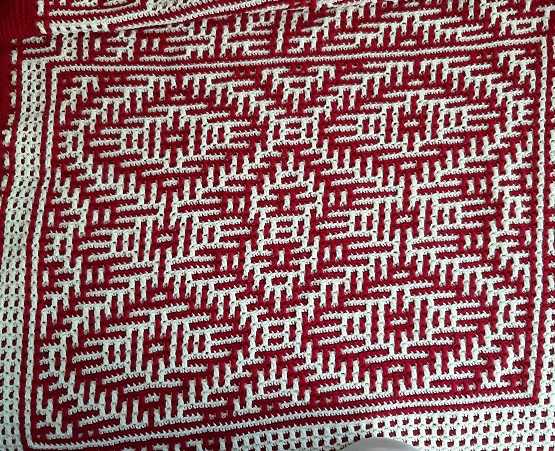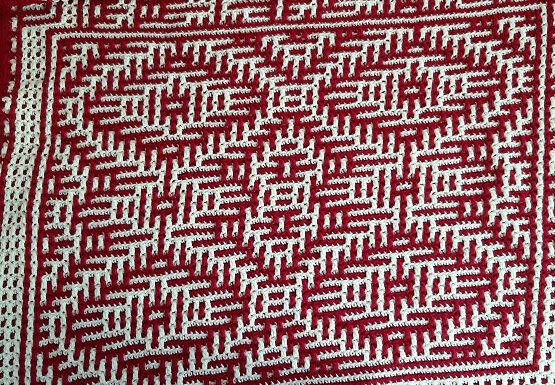Below you find the information about yarns, crochet hooks, sizes and usage. The info below is also in the files on Ravelry, but because this is an adjustable pattern, that you can make as high and wide as you wish, the info is also shown here.
The info is for 2 versions: interlocking and mosaic.
Interwoven / interlocking
For this technique I like to use Alize Cotton Gold for blankets. For a table runner or placemat you could use a more finer yarn like crochet cotton to have more repeats and show the mesmerizing effect a bit better since it’s a smaller surface. For scarfs it is lovely to have a thinner mohair type of yarn. Choose yarns that have a good contrast.

In the HAL CAL 2020 blanket I used these two Alize Cotton Gold colors:
color 1: Cherry, color number 390
color 2: Offwhite, color number 01
Alize Cotton Gold is made of a combination of 55% cotton 45% acrylics.
I use hooksize 4 mm for this yarn. For the border I use 3.5 mm.
The balls are 100 grams (3.53 oz) and have 330 meters on it (361 yards).
The practice piece of 20 x 20 squares of the Hooked and Locked CAL 2018 (if you want to use that one for your gauge) is approximately 21 cm x 21 cm (8 ¼ x 8 ¼ inch). You can also make a piece with 1 repeat of the pattern and see how big this is, and then see how large your project needs to be. Next calculate how many repeats you need horizontally and vertically. Always take extra yarn in color 1 for the border.
To give you an indication of the amount of yarn needed: for a blanket of about 120×160 cm you will need 6 repeats horizontally and 9 repeats vertically. For this you need 800 grams of each color. But to be sure just make a piece first with 1 repeat horizontally and vertically and see how much yarn you needed and then calculate. Next do a border around your piece as described at the border section in this document and see how much yarn you needed for this and then calculate for your final size piece.
Mosaic crochet
For this technique I like to use Alize Cotton Gold for blankets. For a table runner or placemat you could use a more finer yarn like crochet cotton to have more repeats and show the mesmerizing effect a bit better since it’s a smaller surface. For scarfs it is lovely to have a thinner mohair type of yarn. Choose yarns that have a good contrast.

In the HAL CAL 2020 blanket I used these two Alize Cotton Gold colors:
color 1: Cherry, color number 390
color 2: Offwhite, color number 01
Alize Cotton Gold is made of a combination of 55% cotton 45% acrylics.
I use hooksize 4 mm for this yarn.
The balls are 100 grams (3.53 oz) and have 330 meters on it (361 yards).
Calculating how much yarn you need
Each pattern is made by making sc’s and dropdown dc’s. There is no golden rule for estimating how much yarn you need, because it all depends on the pattern and the yarn that you’re using.
The numbers you need are the number of sc’s and dc’s you have to do per color. And then measure how much yarn it takes you to make a dc and a sc with the yarn you planned to use. You can do this for example by making a couple of hundreds dc’s and measure how much yarn (the length) you needed for that, and then divide it by the number of dc’s you made. Do the same for the sc’s. I have charted here how many stitches you need to make per color and per type of stitch.
Sample of a 4×4 block: number of sc’s for color 1
| 576 | 576 | 576 | 594 |
| 576 | 576 | 576 | 594 |
| 576 | 576 | 576 | 594 |
| 648 | 648 | 648 | 670 |
This table shows at the bottom row that the right bottom corner block needs 670 sc’s. Every repeat you add to the left is another 648 sc’s. So if you do a row of just 1 repeat high and 4 repeats wide, you need 670 + 648 + 648 + 648 = 2614 sc’s in color 1.
When you add another repeat op top of the bottom repeats, so it gets 2 repeats high, the figures change a bit. The right repeat needs 594 sc’s and the repeats left to it need each 576 sc’s. So adding another row of repeats take 594 + 576 + 576 + 576 = 2322 sc’s extra.
If you want to add another repeat to the left, then expand the table to the left with 648 sc’s for the bottom repeat and 576 sc’s for each repeat above it. If you want to add another repeat on top, then expand the table on the top with 594 sc’s for the right repeat and 576 sc’s for each repeat left of it.
Sample of a 4×4 block: number of dc’s for color 1
| 180 | 180 | 180 | 216 |
| 180 | 180 | 180 | 216 |
| 180 | 180 | 180 | 216 |
| 192 | 192 | 192 | 230 |
Do the same for the dc’s of color 1 as you did for the sc’s.
You now have the total number of sc’s and dc’s for color 1. Multiply the number of sc’s with the length of yarn per sc, do the same for the dc’s. You now have the length you need for doing the stitches.
Sample of a 4×4 block: number of sc’s for color 2
| 566 | 566 | 566 | 614 |
| 566 | 566 | 566 | 614 |
| 566 | 566 | 566 | 614 |
| 608 | 608 | 608 | 659 |
Sample of a 4×4 block: number of dc’s for color 2
| 190 | 190 | 190 | 196 |
| 190 | 190 | 190 | 196 |
| 190 | 190 | 190 | 196 |
| 190 | 190 | 190 | 196 |
Extra yarn for the borders and the rows
The final things you have to add is how much yarn you need for starting and ending a row and the final border.
With overlay mosaic you have a tail at the end and a tail at the start of a row. I usually take 15 or 20 cm for these. So see how many rows in color 1 and color 2 you have to do for your project, calculate the length of yarn for this and add that to your calculations.
Then calculate how much yarn you need for the surrounding border. When you use the way I do it ( see my tutorial for the border), see how many rows in which color you need or want to make. These are all sc’s, so calculate the yarn needed for this and add that as well.
You now have the amount of yarn that is needed for your project!

